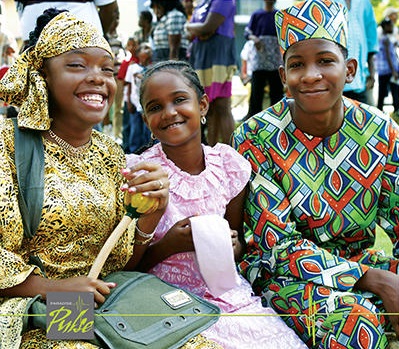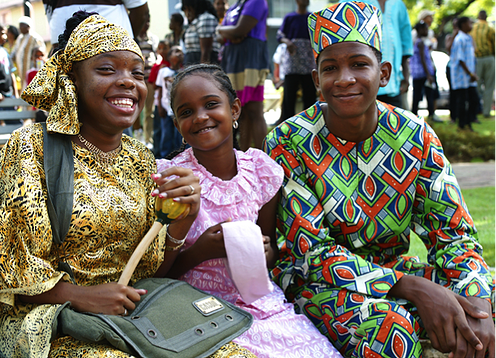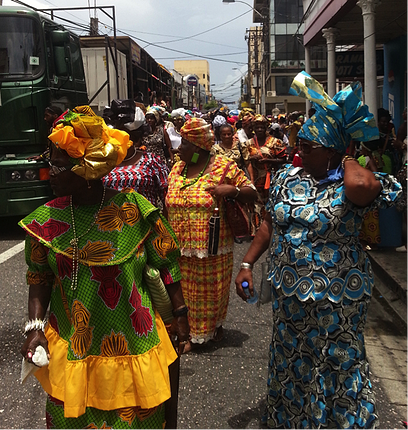 |
|
Anecdote one: At the tender age of five, I had my very first lesson in African consciousness. It was a Commonwealth Day commemoration. As a school project, our teachers asked us to find out about the Commonwealth, and to come to school dressed in the traditional wear of one of its member countries. On my atlas, Canada’s size caused it to feature most significantly among the other pink-coded Commonwealth nations. I resolved that I should go to school as a Canadian, and proudly offered this suggestion to my mother, a seamstress, God rest her soul, with the hope that she would dress me accordingly. My mother immediately refused the suggestion. "How does a Canadian dress?" she asked rhetorically, and quickly followed with, "You're going as an African!" I was confused. "An African?" I asked her. How could I go as an African? Nevertheless, she made me my first dashiki, and sent me to school on Commonwealth Day in my 'African costume'; dashiki and short pants. My teachers, on seeing me, were pleasantly surprised. "Aye! Look! He come as an African!" they remarked. Interestingly, I was the only student dressed as an 'African' in Mount D'or, a community in Trinidad with a significant population of persons of African heritage.

Children dressed in African attire at Emancipation Day celebrations in Trinidad
Anecdote two: As children, my brother and I were made to participate in Best Village. Our mother, among other things, devoted much of her time to managing our community's Best Village group. Culture and community work were thus as mandatory as our household responsibilities. Initially, our participation in Best Village felt like a chore. But we grew to like it. And as we got older, we somehow appreciated its (potential) value. Given our involvement, one of the skills we inherited as children was playing African drums. Learning to play drums demanded that we became cognizant too of some of the traditional chants and songs that constituted our inheritance given the African oral traditions that exist here. One of the many songs we learnt by ear was one which was used sometimes, in Best Village, to accompany calypso drumming or a Limbo dance, the lyrics to which we ‘learnt’ (phonetically) as follows:
See see Moriah, Moriah, Moriah (x 2)
Kambulay, lay, lay, lay, lay oh, Kambulay, one boy, one girl! (x 2)
We never questioned what the song meant. We took it as gospel. We learnt however, that it was linked to the music and dance, by way of the plantation, and Canboulay, which we pronounced Kambulay. More recently, through the research of Rawle Titus, we would find out that the song is a wake song, and “Kambulay” should really be “Tamboulay”; an ode to the drum/ming at the traditional wake. Before this, we were ‘informed’ that “Kambulay” was a mispronunciation of "Canboulay". Indeed, notwithstanding what we possess culturally, one may argue that once a tradition is bequeathed orally there is the risk of a kind of ambiguity, if you will, regarding what is retained. What this particular situation seemed to suggest though, is that ours – if only my brother and mine – was a serious miseducation!
Anecdote three: In my early twenties I worked at the bank. It was customary – if not merely permissible, as not very many persons did – to ‘dress up’ in traditional African wear on the final working day before the Emancipation holiday. One year, a gentleman of White Trinidadian stock walks up to me at the counter. I am dressed in my traditional wear. He remarks, "Nice costume!", to which I retorted, "This is not a costume", to which he responded, "I studied the English language, and that is a costume!" Admittedly, I felt hurt. My theatre mind told me “costume” connoted disguise, and playing something I am not.

Emancipation Day celebrations in Port of Spain, Trinidad in 2014
For now though, let us deal with this wearing a costume business. Let’s also put aside “Tamboulay”, and address “Canboulay”, "Kambulay", and what we eventually learnt.
Canboulay is derived from the French expression cannes brulees: the burning of the canes on the sugar plantation during the period of African enslavement in the Caribbean. Prior to the research of the likes of Professors Maureen Warner-Lewis, Hollis Liverpool (aka calypsonian, Mighty Chalkdust) and Dr. J.D. Elder, for example, it was widely accepted that the Canboulay was the precursor to the Trinidad Carnival, which suggested a French cultural root to the festival. The story goes that whenever there were cane fires on the plantations, enslaved Africans were mustered together by plantation owners to put these out. Characterised by the carrying of torches, blowing of shells/horns, and the cracking of whips, these happenings were re-enacted by Africans after Emancipation, now part of Canboulay, which became the designation given by nineteenth century planters and writers to the ex-enslaved Africans' participation in Carnival.
According to Liverpool, one planter writing to the Port of Spain Gazette in 1881 spoke about "the fire drill and ritual on the estates”, adding that white planters would dance "the bamboula, the giouba and the Calinda [...,] pre-tended [to be] Negues Jardin” (garden Negro or field slave) “and with torches and drums [pretended] to represent what did actually take place" (Port of Spain Gazette 1881:1)."[i] Another planter writing in the Trinidad Chronicle in the same year, endorsed the idea of the Canboulay as a re-enactment of that moment in plantation life, and added that the [Canboulay] procession involved the singing of a "rude refrain to a small negro-drum"[ii].
Note though, that as re-enactment, Canboulay becomes a vehicle for re-presenting (to present again) a community’s truth. For re-enactment to matter, memory, or the re-construction of which, is a critical requisite. Okay, let’s pause here for now. Allow this to marinate, or as we say, coosoomay. Consider the concerns raised in the anecdotes. Make a note of what the research might be suggesting. And, in our follow-up article, we’ll see where this discussion leads.
Endnotes
[i] Liverpool, Hollis. 'Origins of the Rituals and Customs in the Trinidad Carnival'. P. 30
[ii] Liverpool, Hollis. 'Origins of the Rituals and Customs in the Trinidad Carnival'. P. 31
 |
By: Marvin George | MUSIC-CULTURE | September 2014 |
Tweet |
Warning: array_search() expects parameter 2 to be array, null given in /home/paradisepulsea/public_html/pages/article.php on line 87
Warning: in_array() expects parameter 2 to be array, null given in /home/paradisepulsea/public_html/pages/article.php on line 104
Warning: array_search() expects parameter 2 to be array, null given in /home/paradisepulsea/public_html/pages/article.php on line 87
Warning: in_array() expects parameter 2 to be array, null given in /home/paradisepulsea/public_html/pages/article.php on line 104
Warning: array_search() expects parameter 2 to be array, null given in /home/paradisepulsea/public_html/pages/article.php on line 87
Warning: in_array() expects parameter 2 to be array, null given in /home/paradisepulsea/public_html/pages/article.php on line 104


| Subscribe |










%20-%20Copy.jpg)

